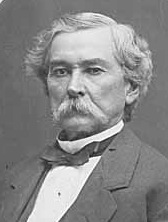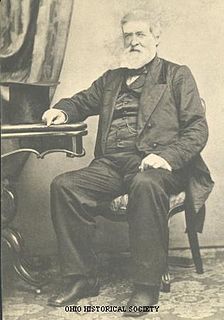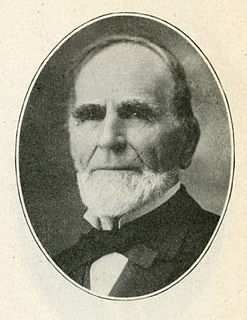
St. Peter is a city located in Nicollet County, Minnesota, United States. The city is located 10 miles north of the Mankato – North Mankato metropolitan area. The population was 11,196 at the 2010 census. It is the county seat of Nicollet County. Saint Peter is the home of Gustavus Adolphus College.

Henry Hastings Sibley was the first Governor of the U.S. state of Minnesota and a U.S. Representative of the Minnesota Territory and the Wisconsin Territory.

Cushman Kellogg Davis was an American Republican politician who served as the seventh Governor of Minnesota and as a U.S. Senator from Minnesota.

Willis Arnold Gorman was an American lawyer, soldier, politician, and a general in the Union Army during the American Civil War.

Samuel Medary was an American newspaper owner and politician.

The Territory of Minnesota was an organized incorporated territory of the United States that existed from March 3, 1849, until May 11, 1858, when the eastern portion of the territory was admitted to the Union as the State of Minnesota.

The Constitution of the State of Minnesota was initially approved by the residents of Minnesota Territory in a special election held on October 13, 1857, and was ratified by the United States Senate on May 11, 1858, marking the admittance of Minnesota to the Union. Nearly 120 amendments have been approved, with perhaps the most significant being a reorganization in 1974 to simplify the document, making it easier for modern readers to comprehend and reducing the extensive verbiage. It is believed that the constitution was even amended twice prior to ratification.

Minnesota's 1962 gubernatorial election was the closest statewide race in Minnesota history and one of the closest gubernatorial elections in American history. The election was held on November 6, 1962, but the results were not known until March 21, 1963. The vote count after election day had Governor Elmer L. Andersen in the lead by 142 votes. Then-Lieutenant Governor Karl Rolvaag went to court and won the right for a recount. After the recount, it was determined that Rolvaag of the DFL had defeated Andersen, Republican, by 91 votes out of over 1.2 million cast. Rolvaag collected 619,842 votes to Andersen's 619,751.

Thomas Wilson was an American lawyer, Minnesota congressman and state legislator, associate justice and the 2nd chief justice of the Minnesota Supreme Court.
Andrew Robert Kiefer was a U.S. Representative from Minnesota; born at Marienborn, Duchy of Hesse-Darmstadt, Germany; he attended school in Mainz; immigrated to the United States in 1849 and settled in St. Paul, Minnesota, in 1855; inspector and collector of the wharf in 1857; engaged in mercantile pursuits; enrolling clerk of the Minnesota House of Representatives in 1859 and 1860; entered the Union Army as captain of the Second Regiment, Minnesota Volunteer Infantry, on July 8, 1861, and served until July 18, 1863, when he was compelled to resign on account of ill health; commissioned by Governor Swift colonel of the Thirty-first Regiment of State militia in 1863; member of the Minnesota House of Representatives in 1864; was engaged in the wholesale mercantile business 1865 – 1878 and in 1880 became interested in real estate; clerk of the district courts of Ramsey County 1878 – 1883; unsuccessful Republican candidate for mayor of St. Paul in 1890; elected as a Republican to the 53rd and 54th congresses, ; was not a candidate for reelection in 1896; mayor of St. Paul in 1898; at the time of his death was the Republican candidate for city controller; died in St. Paul, Ramsey County, Minnesota; interment in Oakland Cemetery.

William Hall Yale was a Minnesota lawyer and Republican politician who served as the sixth Lieutenant Governor of Minnesota.

Charles Andrew Gilman was a Republican Minnesota legislator, Speaker of the Minnesota House of Representatives, and the ninth Lieutenant Governor of Minnesota.

Lyndon Ambrose Smith was an American educator, lawyer and Republican politician who served as the 14th Attorney General and the 15th Lieutenant Governor of Minnesota.

James Gilfillan was an American lawyer and judge from Minnesota. He served as Chief Justice of the Minnesota Supreme Court from 1869 to 1870 and again from 1875 to 1894.

The first Minnesota Legislature first convened on December 2, 1857. The 37 members of the Minnesota Senate and the 80 members of the Minnesota House of Representatives were elected during the General Election of October 13, 1857. Although the Constitution of the State of Minnesota, which had been adopted by the voters at the 1857 general election, was not ratified by the United States Senate until May 11, 1858, this was the first legislature of the State of Minnesota to convene in conformity with the state constitution.
Ara Barton, sometimes listed as Asa Barton was an American politician from the state of Minnesota.
















